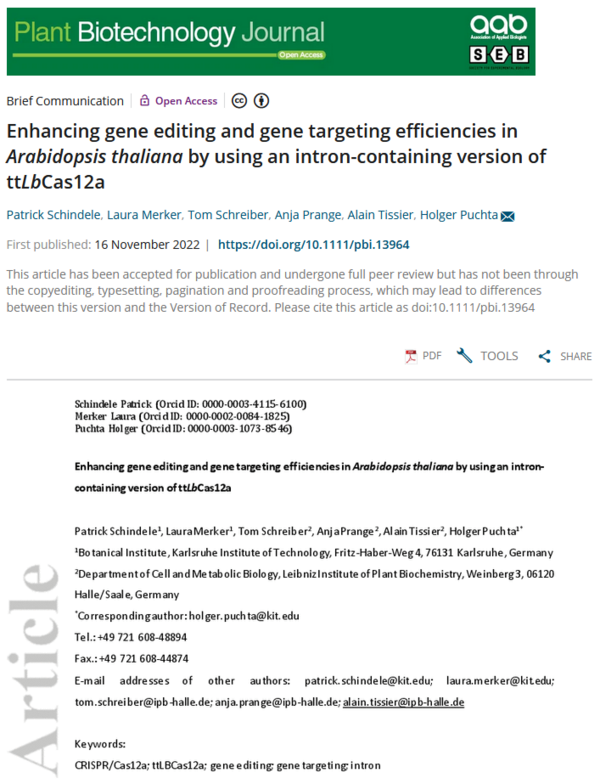Optimized genetic scissors for plants.
Genome editing with CRISPR/Cas has quickly established itself as a fast and effective method for targeted modification of genes. However, there are many variants of this molecular tool and ample room for optimization when it comes to application in different organisms. Scientists from KIT Karlsruhe and IPB have recently succeeded in making a Cas enzyme much more efficient for use in plants.
In genome editing with CRISPR/Cas systems, a Cas endonuclease is directed by a guide RNA to the corresponding DNA target sequence in the organism. There, the endonuclease enzymatically cuts the DNA double strand. The subsequent cellular repair processes, which are error-prone, can render the gene non-functional. Alternatively, by directing the repair mechanisms, a desired mutation can even be inserted, thus altering gene function. In contrast to the widely used Cas9 endonuclease, which cuts both DNA strands at the same point and produces blunt ends, the Cas12a endonuclease yields sticky ends. This means that at the cleavage site, one strand of the DNA double strand ends up being a few nucleotides longer than the other. For various applications, the CRISPR/Cas12a system is more suitable, also because sticky ends can be rejoined more easily. The short single-stranded overhangs are available for binding to complementary sequences allowing repair processes to be manipulated more easily.
In plants, however, Cas12a has not yet been successfully put to use. For one thing, plant cultivation usually involves temperatures that are too low for the enzyme to perform optimally. Secondly, the enzyme does not work efficiently enough, especially with difficult-to-access gene sequences such as those found in heterochromatin, a form of DNA that is tightly packed and wound around proteins. While the Karlsruhe scientists had in the past been able to produce a temperature-tolerant Cas12a variant that was also active in plants at greenhouse conditions of 22°C, the Halle scientists already have experience in increasing the efficiency of Cas9. In a previous work, they made purposeful changes in the coding sequence for Cas9. By incorporating two nuclear localization signals as well as 13 introns, they were able to improve the endonuclease such that it produced a mutation frequency of 70-100% when used in Arabidopsis.The introns, non-coding sequence insertions, presumably provide a significantly increased expression of the nuclease.
In the present study, both teams of scientists have now combined their respective optimization approaches and successfully applied them to Cas12a. Compared to the temperature-tolerant Cas12a variant without modifications, a variant with 10 introns showed significantly increased editing efficiency in Arabidopsis. Notably, an improved performance was achieved especially for target sequences that were difficult to edit. The authors are making their engineered Cas12a construct available via Addgene.
Publikation:
Schindele, P., Merker, L., Schreiber, T., Prange, A., Tissier, A. & Puchta, H. 2022. Enhancing gene editing and gene targeting efficiencies in Arabidopsis thaliana by using an intron‐containing version of ttLbCas12a. Plant Biotechnology Journal. Available at: http://dx.doi.org/10.1111/pbi.13964
Frühere Publikationen:
Grützner, R., Martin, P., Horn, C., Mortensen, S., Cram, E. J., Lee-Parsons, C. W. T., Stuttmann, J. & Marillonnet, S. 2021. High-efficiency genome editing in plants mediated by a Cas9 gene containing multiple introns. Plant Communications 2:100135. Available at: http://dx.doi.org/10.1016/j.xplc.2020.100135
Schindele, P., and Puchta, H. 2020. Engineering CRISPR/LbCas12a for highly efficient, temperature‐tolerant plant gene editing. Plant Biotechnology Journal 18:1118–1120. Available at: http://dx.doi.org/10.1111/pbi.13275



